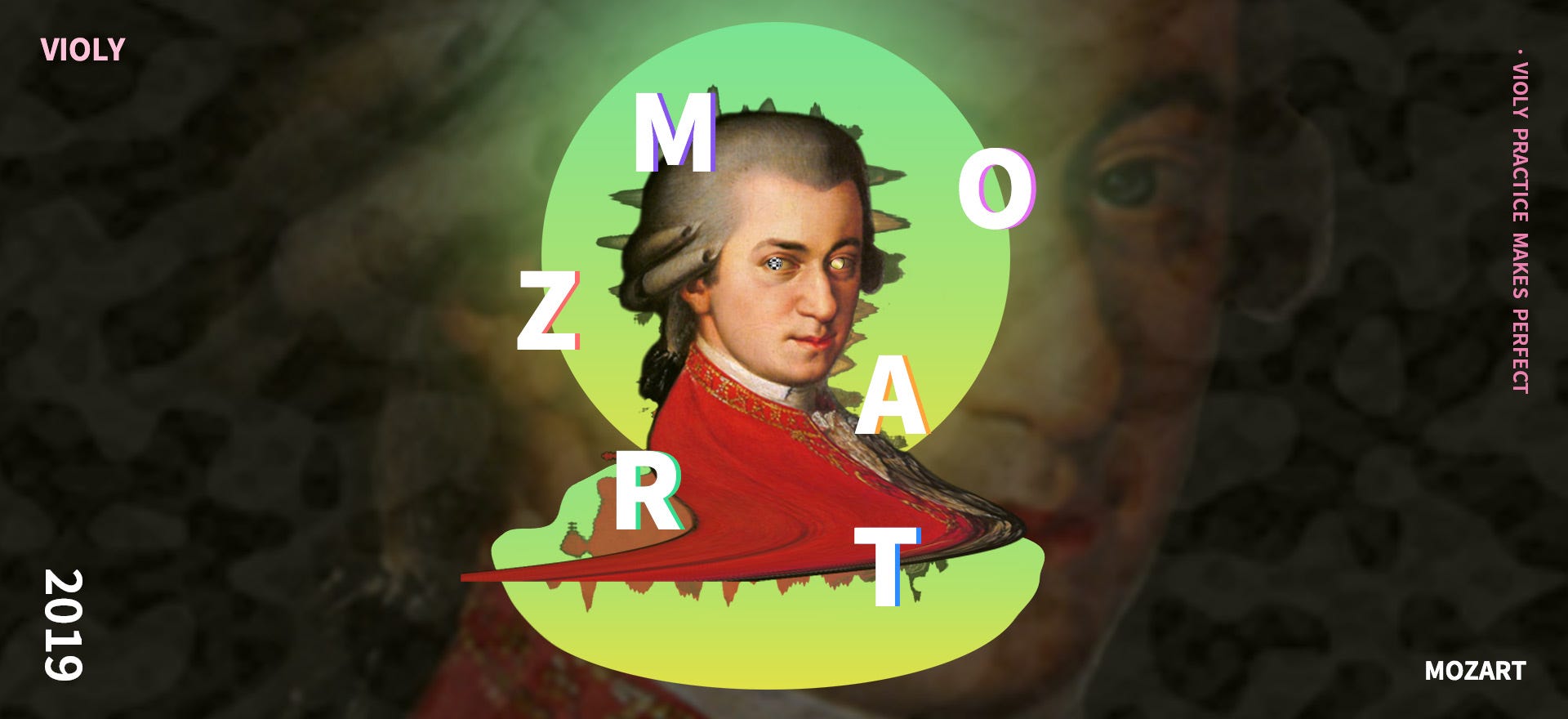Violin Album of Mozart (New Albums on Violy | The BEST Violin App)
Hello, Violy violinists. In this article we will go through the recently added “Albums” of violin repertoires on Violy — the best violin app, which can help you practice ‘violy’. What should be checked out today is the repertoire of Wolfgang Amadeus Mozart, who was praised by Hadyn that “posterity will not see such a talent again in 100 years”.

Violin Music Composer: Wolfgang Amadeus Mozart
Wolfgang Amadeus Mozart (27 January 1756–5 December 1791), was a prolific and influential composer of the classical era. He composed from the age of five and performed before European royalty. At 17, Mozart was engaged as a musician at the Salzburg court. During his final years in Vienna, he composed many of his best-known symphonies, concertos, and operas, and portions of the Requiem, which was largely unfinished at the time of his early death at the age of 35. He composed more than 600 works, many of which are acknowledged as pinnacles of symphonic, concertante, chamber, operatic, and choral music. He is among the most enduringly popular of classical composers, and his influence is profound on subsequent Western art music. Ludwig van Beethoven composed his early works in the shadow of Mozart, and Joseph Haydn was his friend and mentor.
Wolfgang Amadeus Mozart’s Violin Composition
Mozart was a versatile composer, and wrote in every major genre, including symphony, opera, the solo concerto, chamber music, and sonatas. His five violin concertos were written in Salzburg around 1775. They are notable for the beauty of their melodies and the skillful use of the expressive and technical characteristics of the instrument, though Mozart likely never went through all the violin possibilities that others (e.g. Beethoven and Brahms) did after him. Mozart also wrote a concertone, an adagio and two stand-alone rondos for violin and orchestra. He composed a variety of chamber violin music as well, including childhood violin sonatas, mature violin sonatas, variations for violin and piano, string duos and trios, string quartet and string quintet.

Violy Album Contents:
There are totally 25 pieces of music in the self-titled Album of Wolfgang Amadeus Mozart on Violy, including:
4 Spiegelkanons, Allegro | Allegro = 116
Aria from “The Marriage of Figaro” | BPM = 116
- The Marriage of Figaro, K. 492, is an opera buffa (comic opera) in four acts composed in 1786 by Mozart. It premiered at the Burgtheater in Vienna on 1 May 1786. The opera’s libretto is based on a stage comedy by Pierre Beaumarchais, La folle journée, ou le Mariage de Figaro (“The Mad Day, or The Marriage of Figaro”), which was first performed in 1784. The opera is a cornerstone of the repertoire and appears consistently among the top ten in the Operabase list of most frequently performed operas.
Fifth Concerto in A Major, Ⅰ | Allegro aperto Adagio = 66
“Haffner” — Rondo from Serenade №7, K. 250 | Allegretto = 104
Ländler I | Allegretto = 104
Ländler Ⅱ | Allegretto = 104
Ländler Ⅲ | Allegretto = 104
May Song | BPM = 150
Minuet | Moderato = 96
Polonaise — №4 from 12 Duos, K. 487 | Allegretto = 80
Serenade №13 — Eine kleine Nachtmusik | Allegro = 120
The Adélaïde Concerto | Allegro = 120
Turkish March | Allegro = 120
Variations on “Ah vous dirai-je, Maman” | BPM = 100
Violin Concerto №2, K. 211, I | Allegro moderato = 108
Violin Concerto №2, K. 211, II | Andante = 76
Violin Concerto №2, K. 211, III | Allegro = 120
- Violin Concerto №2 in D major K. 211 was composed in 1775. The concerto has the usual fast-slow-fast structure. The movements of the work have the tempo headings: Allegro moderato, Andante and Rondeau, Allegro.
Violin Concerto №3, K. 216, I | Allegro = 120
Violin Concerto №3, K. 216, I, Cadenza | Cadenza = 80
Violin Concerto №3, K. 216, II | Adagio = 66
Violin Concerto №3, K. 216, III | Allegro = 120
- The Violin Concerto №3 in G major, K. 216, was composed in Salzburg when Mozart was 19 years old. He called it in a letter to his father the Straßburger-Concert, and researchers believe this epithet comes from the opening orchestral motive in the third movement, a local, minuet-like dance that had already appeared as a tune in a symphony by Carl Ditters von Dittersdorf. The piece is in three movements: Allegro, Adagio and Rondeau, Allegro.
Violin Concerto №4, K. 218, I| Allegro = 126
Violin Concerto №4, K. 218, II | Andante cantabile = 76
Violin Concerto №4, K. 218, III | Andante grazioso = 76
- Violin Concerto №4 in D major, K. 218, was also composed in 1775 in Salzburg. The autograph of the score is preserved in the Biblioteka Jagiellońska, Kraków. Mozart seemed to have originally composed it for himself to play, but after leaving the Salzburg Court Orchestra, he changed and updated the concerto for the successor of his position in his orchestra, Antonio Brunetti, to play. It is debatable whether the concerto was above Mozart’s level of mastery or if he purposely made the concerto difficult for Brunetti on account of his greater ability. The first movement is nicknamed the “military” Mozart Concerto while the second movement consists of melodic lines. The third movement is joyful and full of fun.
- Wiegenlied | Andante = 76
In this series of article, we will introduce you the music pieces of
Wolfgang Amadeus Mozart,
Ludwig van Beethoven,
Felix Mendelssohn,
Pyotr Ilyich Tchaikovsky,
and finally, Dmitri Shostakovich.
Stay tuned, Violy musicians, let’s bring the music fashion of violin back~
Ref:
https://en.wikipedia.org/wiki/List_of_compositions_by_Wolfgang_Amadeus_Mozart
https://en.wikipedia.org/wiki/Violin_Concerto_No._2_(Mozart)
https://en.wikipedia.org/wiki/Violin_Concerto_No._3_(Mozart)
- https://en.wikipedia.org/wiki/Violin_Concerto_No._4_(Mozart)
- https://en.wikipedia.org/wiki/The_Marriage_of_Figaro
Have a HAPPY practice!!
#ViolyPractice makes Perfect!!
Follow us on: Violy.app
Feel free to contact us at Support@Violy.app
